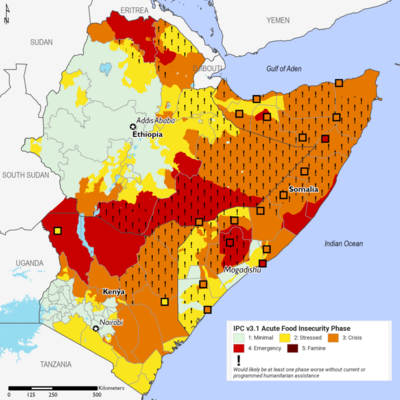
Search
Horn of Africa drought (2020–present)

The 2020–present Horn of Africa drought is an ongoing drought that hit the countries of Somalia, Ethiopia, and Kenya. The rainy season of 2022 was recorded to be the driest in over 40 years, with an estimated 43,000 in Somalia dying in 2022. As of 2023, the region is now in its 5th failed rainy season and a 6th failed season is predicted.
Background
The drought is preceded by the 2011 East Africa drought and the 2017 Somali drought, and is caused by the El Niño effect. The negative conditions of the Indian Ocean Dipole is also a contributor to the drought.
Humanitarian situation
As of 2023 46.3 million were affected by the drought. This includes 9 million women of reproductive age (15 to 49 years) who face dangers to their health and aggravated risks of gender-based violence due to the drought. 13.5 million have been internally displaced while 4.5 million have become international refugees. With 9.5 million livestock being reported dead, broken down into 4 million in Ethiopia, 2.5 million in Kenya and over 3 million in Somalia, the region has seen monetary losses resulting in $1.5 billion being lost in livestock alone.
Somalia
In Somalia it is estimated that 6.7 million have been severely affected by the drought, with 1.8 million children left malnourished. In Somalia an estimated 51.4k have been internationally displaced while 3.1 million remain displaced internally. The droughts effects are further exacerbated by the Russo-Ukrainian War, as Somalia exported 90% of its wheat from the region, with its own farming capabilities destroyed in the 3 decade long Somali Civil War. By 2022 the drought had already claimed the lives of 43,000 people in Somalia half of which under the age of 5. The Baidoa and Burhakaba districts in the Bay region of the country are the most affected and are closest to famine as of now.
Response by Governments and Organisations
In Somalia the government has launched the SURP-II (Somalia Urban Resilience and Project Phase II) programme, which would mainly help Garowe, Baidoa, and Mogadishu deal with the drought by providing monetary assiatance and health kits towards households, constructing communal latrines and emergency water supplies, and also providing further healthcare via mobile clinics. The World Bank has pledged to give 70 million USD to finance this initiative.
The World Health Organisation has also collaborated with local forces to fight diseases like cholera and measles, which have seen a resurgence in Somalia due to the drought, distributing Vitamin A, offering deworming services, and vaccination campaigns.
Kenya
In Kenya the northernmost regions of the country, the Turkana, Samburu, Marsabit, Isiolo, Mandera, and Garissa counties remain the most affected by the drought, Kenya's Arid and Semi-Arid Lands, or ASAL. The drought has exacerbated conflict in the region, with the nations pastoralists being most affected, with the violence growing to such an issue that Uhuru Kenyatta, the president of Kenya, deemed it a "national emergency". Furthermore, a large amount of school children have had to drop out to support their families due to the situation.
Response by Governments and Organisations
The Kenyan government has taken steps to protect pastoralists against the drought, allowing pastoralists to sign up in a $120 million insurance scheme that will help them when drought hits, backed by the World Bank.
Ethiopia
Overall
On 29 March 2022, the International Federation of Red Cross And Red Crescent Societies (IFCR) reported that 6.8 million Ethiopians were in need of humanitarian assistance. By October the same year, UNICEF reported that around 29.7 million people in Ethiopia were in need of humanitarian assistance.
In northern Ethiopia
Livestock and wildlife
Pastoralists have reported much of their livestock perishing in the drought. In 2021, half of the lifestock of men in the town of Kargi, Kenya was reported to have died, with 2.4 million livestock perishing in the entirety of Kenya.
Furthermore, the deaths of
- 205 elephants
- 512 wildebeests
- 381 common zebras
- 51 buffalos
- 49 Grévy's zebras
- 12 giraffes
were reported between September 2021 to 2022 May by the Kenya Wildlife Service in the Amboseli, Tsavo and Laikipia-Samburu areas.
See also
- 2017 Somali drought
References
Text submitted to CC-BY-SA license. Source: Horn of Africa drought (2020–present) by Wikipedia (Historical)
Articles connexes
- 2011 East Africa drought
- Somali drought (2021–present)
- Drought
- List of droughts
- Africa
- Desertification in Africa
- Horn of Africa
- World food crises (2022–present)
- Droughts in the Sahel
- Famine in northern Ethiopia (2020–present)
- 2017 Somali drought
- Famine
- People's Democratic Republic of Ethiopia
- 1983–1985 famine in Ethiopia
- History of Africa
- 2019–2022 locust infestation
- East Africa
- Effects of climate change on agriculture
- African humid period
- Sudanese civil war (2023–present)
Owlapps.net - since 2012 - Les chouettes applications du hibou

